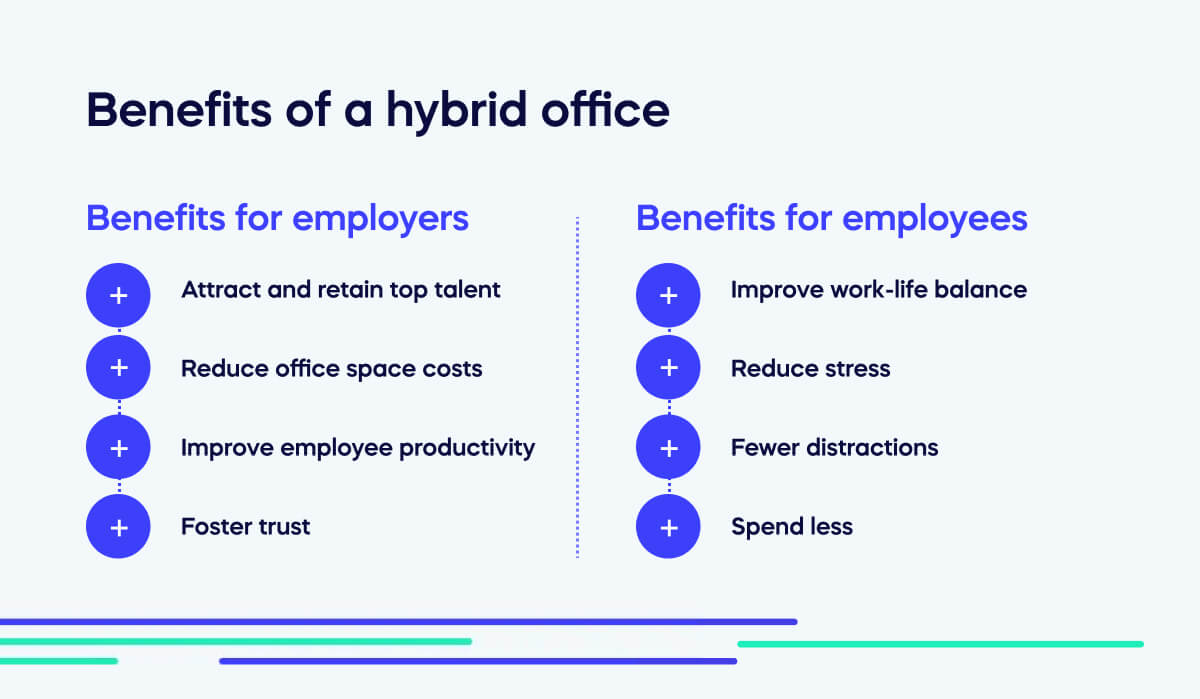A hybrid office is a workplace arrangement whereby employees spend some days working together in an office and some days working remotely.
Both workers and employers benefit from increased flexibility with a hybrid workforce. They can collaborate in person for meetings, training, and other social activities during office days, then benefit from quieter environments for increased productivity when they are WFH.

Workplaces will offer a range of different hybrid office arrangements. For example:
- Employers may only hire office space during certain days of the week or month
- Employees may come in on set days of the week, e.g., Mondays and Tuesdays, then work remotely for the rest of the week
- Employees may come in on set days during the month, e.g., for weekly or bi-monthly meetings
- Employers may have downsized their office space after the pandemic and only have room for a limited number of employees to be in the office per day
- Employers may operate a flexible hybrid schedule where employees can choose when they work remotely or when they come into the office
- Employers may operate a remote-first policy, where it is assumed that people will work from home – but on certain days, they may be required to come in on an ad-hoc basis. They are also free to work in the office whenever they choose
When did the hybrid office start?
Hybrid offices have been around for as long as the internet has enabled people to work. Over time, the number of people working in a hybrid office environment has steadily risen. For example, data from the US Census reveals that in 2010, 13.4 million people worked at least one day at home per week, an increase of 35% since 1997.
The COVID-19 lockdowns forced workplaces to become fully remote or at least offer hybrid working models where possible. When restrictions began to loosen, many employees returned to the office – but not to the same extent as they were before the pandemic. Indeed, research from McKinsey shows that in fall 2022, workers were going to the office an average of just 3.5 days per week – 30 percent below pre-pandemic norms.
While some companies were operating with hybrid offices before COVID-19, the pandemic led to a larger number of businesses pivoting to offer this model post-lockdown restrictions. In fact, a hybrid workplace is quickly becoming the ‘Next Normal,’ with Gartner forecasting that 39% of global knowledge workers will work hybrid by the end of 2023.
Benefits of a hybrid office
Hybrid offices provide benefits for both employers and employees.
Benefits for employers
Attract and retain top talent.
Offering a flexible working environment makes your workplace look more attractive to prospective employees and promotes employee retention. McKinsey’s research on workplace flexibility reveals that, among those who prefer hybrid work models, 71% say they are likely to look for other opportunities if their current employers discontinue those models. Employers increasingly recognize that they will be missing out on top talent by insisting on office attendance 100% of the time.
Reduce office space costs.
Companies don’t have to spend as much on office space if they aren’t housing their entire workforce every day of the week. By downsizing or only having the office open on set days, running and rental costs will be reduced – and these funds can be reinvested into other areas of the business.
Improve employee productivity
During the height of the pandemic, 58% of executives reported that the productivity of individual employees had improved. The reality is that some people are more productive working from home. Therefore, creating dedicated days for office-based activities such as meetings and training alongside specific days where people can get their heads down and power through tasks can result in improved employee productivity.
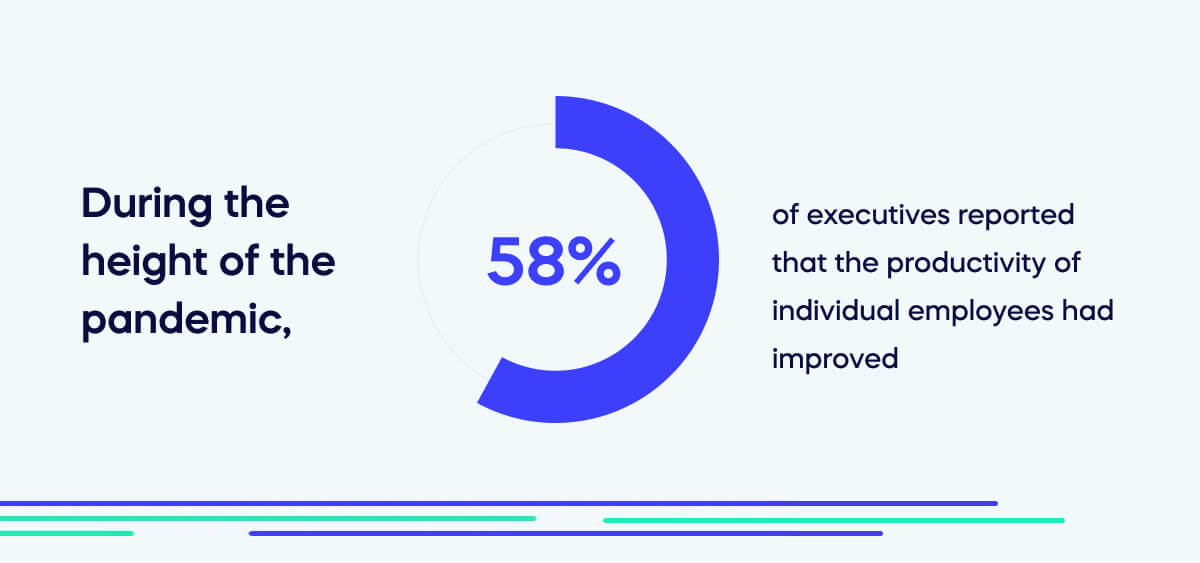
Foster trust
By giving employees the flexibility to work in an office environment and in a place of their choosing, employers indicate that they trust the workforce to get the job done regardless of where they are located. Employees will appreciate not feeling like they’re constantly being monitored and that their output can be relied on.
Benefits for employees
Improve work-life balance
Employees with responsibilities such as childcare or who need to juggle appointments – from doctors to plumbers – will benefit from the flexibility of working from home when it’s more convenient. What’s more, reduced commuting time means that employees have more time to spend with family, friends, and loved ones – resulting in a better work-life balance.
Reduce stress
Some employees may not perform well in environments surrounded by people or feel under pressure due to the nature of a bustling office. Stress levels can be managed more effectively by having set days where they can rest and recharge, yet still get their jobs done.
Fewer distractions
While offices are ideal for fostering collaboration, holding meetings, hosting training sessions, and socializing with colleagues, the reality is that workplaces are a hive of distractions. Whether it’s regular coffee breaks, catching up with colleagues over lunch, or having visitors into the space, hours of time can go by without much actual work being done.
Working from home means people can focus all their attention on specific tasks – and get them done without distractions.
Spend less
Whether commuting to the office and back, childcare, lunches from the local cafe, or dog walkers, having more time at home means that costs like these can be reduced. Employees will benefit from having more disposable income and the ability to cut back costs in areas that were draining their finances when they were based in the office full-time.
Drawbacks of a hybrid office
While hybrid offices work well for many companies, there are some downsides to be aware of.
Drawbacks for employers
Convincing employees to come into the office
Once employees begin enjoying the benefits of working remotely, such as reduced costs, increased productivity, and a better work-life balance, it can be difficult to provide an incentive to return to the office. When employees can provide deliverables quicker and still host meetings, albeit virtually, there is sometimes no argument for bringing people into an office environment. Plus, if employers make it a requirement for people to come in full-time, they risk losing top talent – as people could jump ship and work for an employer that offers a hybrid office or remote working model.
Managing two different employee experiences
With a hybrid office, there are two separate working experiences – the office day and the remote working day. Employers are tasked with maintaining both environments and ensuring business operations run smoothly regardless of where people are located. On some days, there may be a portion of people in the office while others are working remotely, and managing two environments simultaneously can present unique challenges.
Developing a company culture
Social rapport isn’t generated when people aren’t always in the office. According to the Hubspot 2023 Hybrid Work Report, 33% of flex employees find relationship building the biggest challenge of working with a hybrid team. Moreover, the chances of maintaining a cohesive company culture go down with a hybrid office. People working across different departments may never see each other or even know they work for the company, whereas an open plan office helps with facilitating cross-department collaboration.
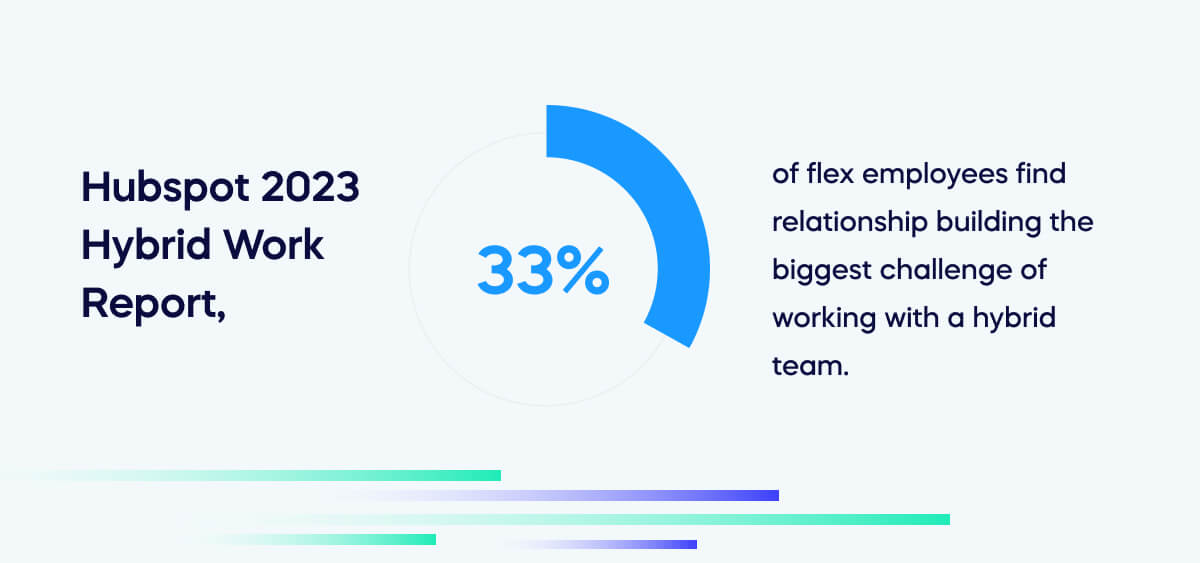
Managing office space
Hybrid offices must be carefully managed so that the space isn’t too large for the average number of people coming in each day, as this would be a waste of money. Conversely, downsizing too much could result in overcrowding if most of the office came in on a certain day. As a result, employers are tasked with ensuring the central hub is carefully managed – they may need to draw up a schedule to ensure that enough desks are allocated for staff.
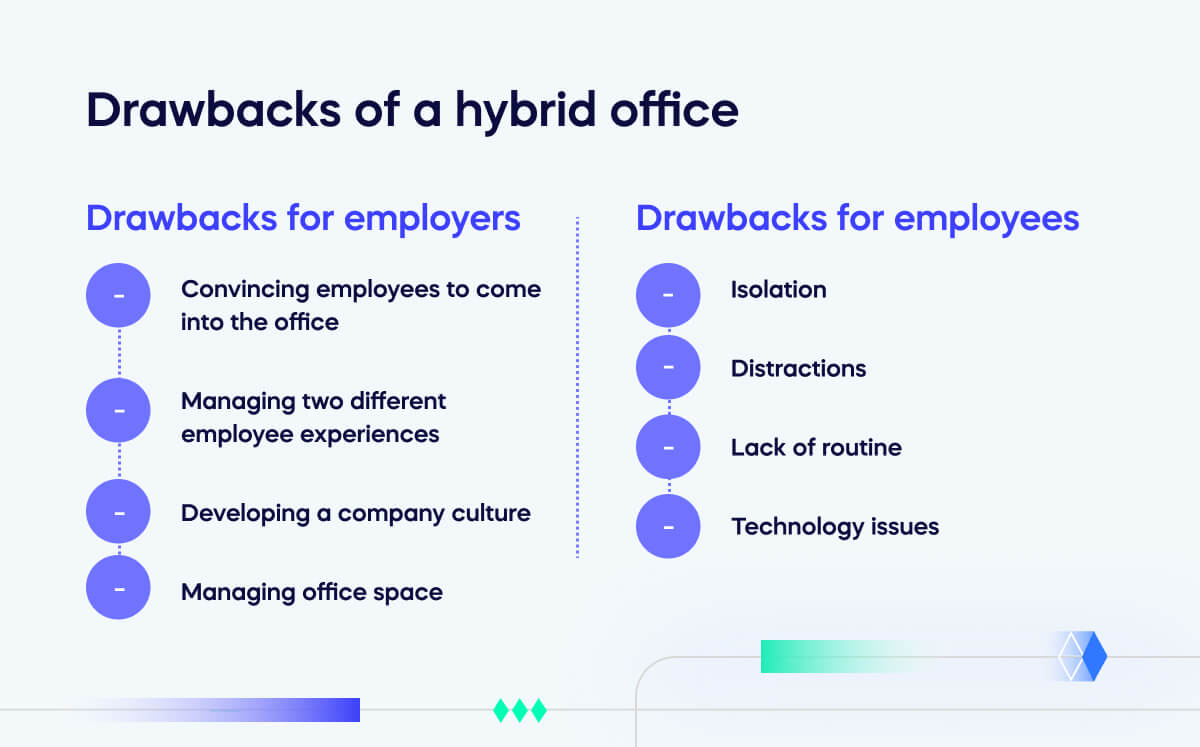
Drawbacks for employees
Isolation
Remote working can be isolating for people, particularly if they live alone. Adjusting to a hybrid office can be difficult for those who appreciate working surrounded by people and talking to them physically when encountering a problem. Spending a portion of the week working in an isolated environment can lead to mental health issues such as depression.
Distractions
While offices provide their own distractions, working at home can be distracting for different reasons. Having easy access to the TV, the temptation to work from bed, or lounging on the sofa can all detract from productivity. Similarly, having noisy people in your home, whether it’s housemates, family members, or children, can also prevent you from getting work done.
Lack of routine
If there aren’t set days for everyone to be in the office, then it can be difficult to maintain a routine during the course of the working week. Going into an office regularly can provide comfort for those who like their days to pan out similarly – getting a bus or train ride, saying hello to familiar faces, and ordering their regular in the local coffee shop. Without routine, some people may struggle with organizing their working week.
Technology issues
Switching from an office computer to a laptop can be difficult for people benefiting from the larger monitors and superior tech specifications of workplace hardware. What’s more, if people encounter problems with their equipment, there is no on-site IT support to help – and employees may be forced to travel into the office at the last minute to resolve the issue, or have to give up on work for the day.
How to set up a hybrid office
These four steps will get you on the right path toward setting up a successful hybrid office.
Create a clear policy
Putting a hybrid office policy in place will ensure that employees understand what is expected of them. Ensure the policy answers the following questions:
Who can work remotely? – Outline the positions that can be worked remotely and be clear about who needs to be physically present each day.
When will employees come in? – Make it clear when workers will be expected in the office. This is where workplaces have the most flexibility. They may stipulate set ‘office days’ or have certain departments come in on certain days. Perhaps set days of the month must be office-based due to events, internal meetings, or client meetings.
What are the hours of work? – Describe what the working hours will be. If they are becoming more flexible, make this clear in the policy. If the working hours remain the same, ensure employees know they need to be logged on or in the office by a certain time each morning.
What technology is provided? – Ensure employees know what their remote working setup will be. If the previous setup was computers, will employees now get laptops to take home for remote days as part of an anywhere operation model?
Will they purchase remote office equipment, such as a laptop or an office chair? What standards must each laptop meet, such as having a working webcam and microphone for video calls? What tools and apps must be installed on the laptops – and what must staff know how to operate to work effectively from home?
What security measures are in place? – Security protocols are already a top consideration, but with employees now able to log onto the company intranet or access company resources from their chosen locations, ensure ground rules are in place. For example, employees may need to use private networks to access restricted materials, or you may provide a VPN subscription for all employees to use for their online tasks.
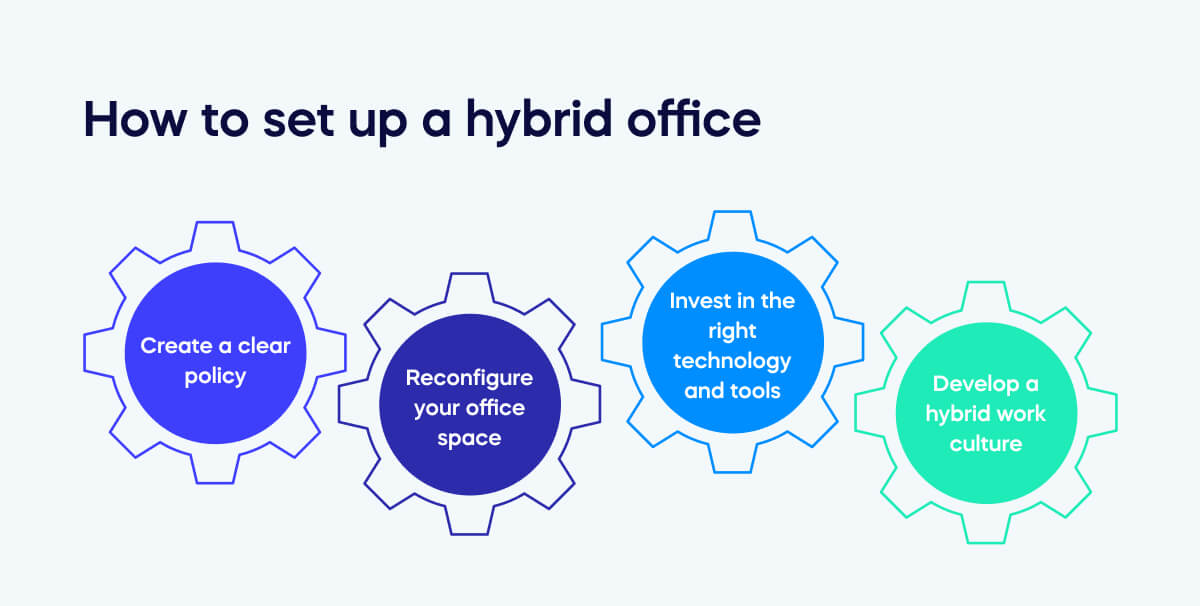
Reconfigure your office space
Decide whether you need the same office space with a hybrid working model. For example, you may be able to downsize and save on running costs if fewer employees are physically present daily.
If the focus of office days will increasingly be on collaboration and meetings, then the space may need rearranging to facilitate these activities. Rows of desks and computers won’t necessarily be appropriate if you bring employees in for a day of meetings. Likewise, if the office space will primarily be used for welcoming clients, ensure it is arranged accordingly.
Overall, ensure the office space acts as a central hub and still reflects organizational values.
Invest in the right technology and tools
Remote working makes having access to certain tools and technology vital. In the hybrid working policy, you will have laid out the equipment workers will be provided with, such as laptops, headsets, and webcams.
Additional resources such as software licenses and access to web-based platforms will also be needed, and cloud transformation may be necessary as part of the shift to a hybrid office model. Here are some of the essentials for remote working.
Project management tools – Monitoring projects and fostering collaboration from employees either in the office or working remotely is vital. Ensure all employees have accounts on a chosen project management tool, such as Asana, Jira, Monday, or Trello, and document all updates there.
Communication platforms – Ensure one platform is chosen for day-to-day communication, such as Microsoft Teams or Slack, and ensure all staff are trained to use it. These platforms will be used for 1-2-1 conversations, group chats, and virtual meetings.
File management solutions – Sharing, collaborating, and developing deliverables is much easier when files are stored on a cloud-based system. A platform like Google Drive or Microsoft Sharepoint can house all company information and employee documents.
Develop a hybrid work culture
There are several features that a successful hybrid work culture has:
- Prioritizes trust and collaboration so that employees feel comfortable working remotely
- Ensures all employees are included day-to-day regardless of their working location
- Prizes innovative working culture with employees demonstrating adaptability
- Schedules social events, both in-person and virtual, to strengthen coworker bonds
- Focuses on wellbeing by providing regular check-ins and helping with creating consistently comfortable work environments
- Nurtures professional development with performance reviews and training materials
The future of the hybrid office
While the technology to facilitate hybrid office models has existed for decades, companies have hesitated to adopt a more flexible approach to how employees work.
Over half of the McKinsey State of Organizations Survey respondents reported that their team leaders were either uncomfortable or barely comfortable leading remote or hybrid teams.
However, the pandemic has ignited employees’ desire to work more flexibly. A 2023 survey from Zippia reveals that 44% of US employees prefer a hybrid work model.
The survey also revealed that 75% of US companies are using or plan to implement a permanent hybrid work model, 55% of employees want to work remotely at least three days a week, and 63% of high-growth companies use a ‘productivity anywhere’ hybrid work model.
Trends, therefore, indicate that the office landscape has been permanently altered. We are unlikely to see densely packed, open-plan office spaces.
Big offices will remain the hub for business – but it’s highly unlikely that many organizations will ask all their employees to return to full-time office work.
Having small groups of employees working in the office occasionally can preserve company culture and camaraderie that can’t necessarily be replicated with technology such as video calls.
However, it will no longer be how businesses operate 100% of the time – as the future workplace will likely be a mix of remote and in-office work.
Ultimately, technology is the key to keeping employees connected and ensuring smooth workflows, with digital transformation becoming increasingly important for organizational success.
